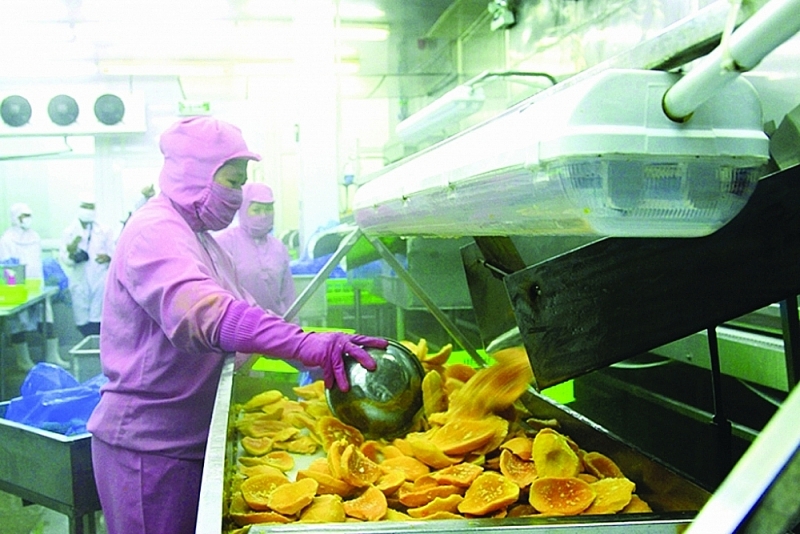 |
| Agricultural and fishery enterprises need to make timely adjustments to meet the changing regulations in Orders 248 and 249. Photo: Nguyen Thanh |
Locals and businesses are still confused
A representative of the Vietnam SPS Office (Ministry of Agriculture and Rural Development) said that, according to Orders 248 and 249, for the food safety management and supervision system, China will establish a model of inspection and assessment of food safety from foreign countries (including national and enterprise systems); supplementing methods of inspection, assessment, management of registration of foreign enterprises, ensuring traceability and product recall according to supervision requirements; requiring the responsibility of the competent authorities to manage the exporting country.
In addition, Orders 248 and 249 emphasize the increased control regulations including increasing the sampling rate for monitoring imported food, respectively. Enterprises must register when producing and exporting 18 food groups to the Chinese market. For products that do not fall into this group of 18, enterprises will submit registration documents themselves or entrust an agent to do so.
From a local perspective, Phan Van Tan, Deputy Director of Binh Thuan Department of Agriculture and Rural Development, said Binh Thuan’s dragon fruit output is about 600,000-700,000 tons/year. In which, about 70-80% of output is exported to the Chinese market. Since 2018, the Plant Protection Department (Ministry of Agriculture and Rural Development) has granted 68 growing area codes and 268 processing and packaging establishments for dragon fruit products for export to the Chinese market. This is advantageous.
However, at present, new enterprises exporting products to the Chinese market are still confused about the new provisions of Orders 248 and 249. Officials receive dossiers and guide procedures according to the provisions of these orders are also confused. “Therefore, we suggest that the Vietnam SPS Office and relevant agencies of the Ministry of Agriculture and Rural Development issue documents or provide more detailed instructions for convenient implementation by localities, enterprises, cooperatives,” Tan said.
In Long An province, Dinh Thi Phuong Khanh, Deputy Director of Long An Department of Agriculture and Rural Development, said that since 2015, the province has standardized the raw material area. Currently, the province has issued many planting area codes (217 codes) and standardized the database. Particularly for the Chinese market, Long An was granted 69 codes. Long An advocates building a source material area with traceability, associated with the responsibility of people and businesses.
Particularly for Orders 248 and 249, the Department of Agriculture and Rural Development has advised the People’s Committee of Long An province on the development of an appropriate set of regulations.
“Long An will radically change people’s perception of the Chinese market. The province has gathered 26 businesses in the area to register. In addition, the province also reviews export products, organizes many popular conferences for dragon fruit export enterprises,” said Khanh.
Sharing the current difficulty of Long An province when the establishment changes the planting area code, the leader of Long An Department of Agriculture and Rural Development proposed that the Ministry of Agriculture and Rural Development have more specific and detailed instructions on online checking procedures and specifications.
“Long An’s dragon fruit products are mainly for export. Therefore, the province is very eager to have documents and illustrations to disseminate details to businesses. In addition, from now until the end of the year, the Department of Agriculture and Rural Development of Long An has requested the Plant Protection Department to have more direct instruction sessions to standardize the process. Along with that, the locality also wants smooth information from parties such as border gates, partner enterprises as well as Chinese management agencies,” said Dinh Thi Phuong Khanh.
Establishing a working group to guide businesses
On the side of enterprises, Ngo Tuong Vy, Deputy General Director of Chanh Thu Fruit Import-Export Co., Ltd. acknowledged that the new regulations of the Chinese market are a signal to change Vietnam’s thinking on agricultural production. However, what Vy is worried about at the moment is that the situation of enterprises exporting to China has not yet met the requirements.
“There is a need to recommend management agencies to coordinate and notify provincial Departments of Agriculture and Rural Development to survey businesses and establishments that already have codes before the Chinese side conducts online checks. This will help businesses and establishments really ensure the standards set forth by the partners,” said Ngo Tuong Vy.
Nguyen Lan Huong, Chairman of the Board of Directors of Hoa Viet International Agriculture Joint Stock Company, said that currently, Hoa Viet Company is aiming to export durian, sweet potatoes and chili peppers through official channels to China. China is a market that the whole world “covets” not only Vietnam. “Our company has been exporting bananas to the Chinese market since 2013, but surely no one knows that we deal in bananas because we only act as an export intermediary for Chinese importers. This order is also for Vietnamese enterprises to express themselves on packaging,” said Nguyen Lan Huong.
Regarding long-term development, the leader of Hoa Viet Company said that Vietnam needs a specific strategy to brand Vietnamese agricultural products in the Chinese market. Building a brand must start from managing the quality of agricultural products, from the process of farming, harvesting, processing, packaging and transportation. “State management agencies need to set up centers and working groups to guide enterprises, cooperatives and specialized local agencies to carry out the procedures required by the Chinese market. We are willing to pay for specific guidance on this issue,” said Nguyen Lan Huong.
Representatives of a number of agricultural and fishery enterprises said that in the immediate future, the Vietnam SPS Office, the Plant Protection Department and relevant agencies need to issue a set of standard documents to guide the step-by-step implementation of the procedures according to the market requirements for each specific product.
